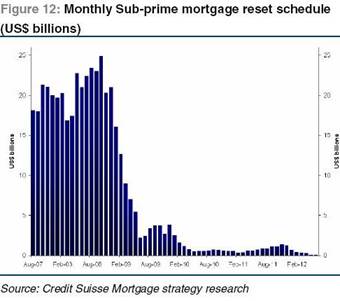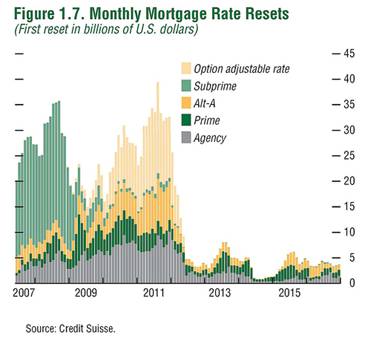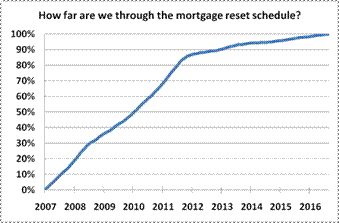From John Hussman 3/30/09 http://www.hussman.net/wmc/wmc090330.htm



JN here; So it appears to me that we are nearing the end of the top half of the third inning (that is 2 1/2 innings have been played) and about 40% of all mortgages have reset, and there is much still ahead.
Hussman also:

Unfortunately, the reset schedule above depicts only sub-prime mortgages. As the recent housing bubble progressed, the profile of mortgage originations changed, so that at the very peak of the housing bubble, new originations took the form of Alt-As (low or no requirement to document income) and Option-ARMs (teaser rates, with no required principal repayments).
A broader profile of mortgage resets is presented below (though even this chart does not include the full range of adjustable mortgage products).
A broader profile of mortgage resets is presented below (though even this chart does not include the full range of adjustable mortgage products).

This reset profile is of great concern, because the majority of resets are still ahead. Moreover, the mortgages to which these resets will apply are primarily those originated late in the housing bubble, at the highest prices, and therefore having the largest probable loss. Though many of these mortgages are tied to LIBOR, and therefore benefit from low LIBOR rates, the interest rates on the mortgages are typically reset to a significant spread above LIBOR, and this spread remains constant as interest rates change. Undoubtedly, some Alt-A and option-ARM foreclosures have already occurred, but the likelihood is that major additional foreclosures and mortgage losses lie ahead. If we fail to address foreclosure abatement during the current window of opportunity (early to mid-2009), there may not be time for legislative efforts to contain the resulting fallout.

JN here; So it appears to me that we are nearing the end of the top half of the third inning (that is 2 1/2 innings have been played) and about 40% of all mortgages have reset, and there is much still ahead.
Hussman also:
In short, attempting to avoid the need for debt restructuring by wasting trillions in public funds increases the likelihood that the current economic downturn will be prolonged, places a massive claim on our future production in order to transfer our nation's wealth to the bondholders of mismanaged financial companies, and raises the likelihood that any nascent recovery will be cut short by inflation pressures. We are nowhere near the completion of this deleveraging cycle.
Comment